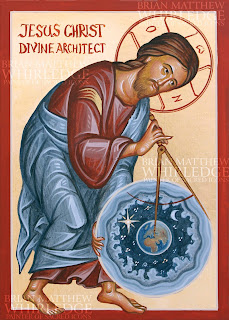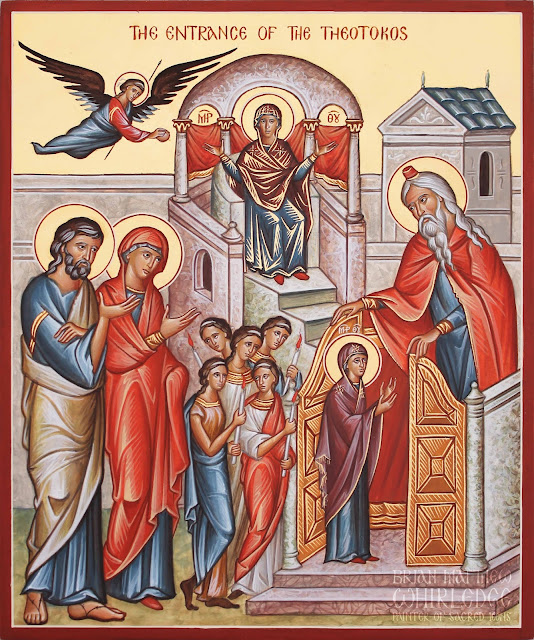Ravenna, Day Two
George woke up at dawn, as usual, and he and I played with Legos for a while until Bekah woke up. Our AirBnB host was gracious enough to leave a bunch of toys for George to play with. It’s been a real help! Our first stop today was the Arian Baptistry. The small octagonal chapel was built by Ostrogothic King Theodoric at the end of the 5th century, at the same time as the Basilica of Sant'Apollinare Nuovo, about a century later than the Orthodox Baptistry we saw yesterday. Once the Orthodox prevailed during the reign of Justinian, this building was converted into a chapel. It is much smaller than the Orthodox Baptistry, and the only remaining decoration is the ceiling of the dome. It follows the same composition as the Orthodox Baptistry: the Baptism of Christ by St, John in the center, surrounded by the 12 Apostles. The figures of the Apostles are exquisite, more refined than the older Orthodox baptistry. I will certainly reference them in upcoming murals!
A young, beautiful Christ arrayed in imperial purple is enthroned on an orb. He is flanked by angels, and is offering a martyr’s crown to St. Vitaly. On the right, Archbishop Ecclesius (who began the construction) offers a model of the church to Christ.
Below this scene on each side are the famous portraits of Emperor Justinian and his wife Empress Theodora. They are in a liturgical procession, offering the Eucharistic elements to the clergy. Flanking St. Justinian are Julian (the ktetor or founder) and General Belissarius, who retook Ravenna (and much of the Mediterranean).
I’ve studied, sketched, and referenced images from San Vitale for years, but just from others’ photos. It was unreal to see them in person and in context. The space was much taller than I imagined, the figures smaller and more distant. I was impressed by the decorative elements, many patterns are still common in Byzantine art today. The elegant figures still retain much from classical antiquity: their postures and their garments. It’s so fascinating the catch a glimpse of this early Christian art as Christian artists were finding their way: using the visual vernacular of their day while transfiguring the art into a thoroughly Christian expression. It’s interesting to see Christ as a beardless youth (so common in Ravenna), before his countenance was crystallized as the bearded man we know. Other elements, such as the Lamb of God, did not survive the iconoclastic controversy, so we do not have these images in our churches today (briefly, icons are acceptable because God became Man; he did not become a sheep, so we can’t depict him as one in an icon). Other elements, such as Christ enthroned wearing regal garments, remain until today.
After lunch, we visited Classe to see the last monument in Ravenna, Sant’Apollinare in Classe. Saint Apollinaris was a first century saint from Antioch, and possibly one of Christ’s 72 apostles. Saint Peter ordained him to the episcopacy and commissioned him to evangelize this region. He was martyred in Classe, where his relics resided for centuries until being transferred to the new basilica of Sant’Apollinare Nuovo in nearby Ravenna. Classe, 3-1/2 miles south of Ravenna, was an ancient port, now several miles inland from the sea due to flooding depositing sediment. We took the best mode of transportation: bicycle! We rented bikes from a local shop for 3 Euros each, and rode through town and country to Classe. We could see the enormous church almost as soon as we left Ravenna.
Entering from a side aisle, I was immediately impressed by the scale. The columns obscured the apse mosaic from the side entrance. The heavy timber ceiling was gorgeous and made me really excited about our parish’s new temple construction project. As I walked past the columns into the central nave, I caught my first glimpse of the splendid apse mosaic masterpiece. I was so caught up in the beauty of this masterpiece, I felt my heart in my throat. There are no words to describe the brilliant colors and the genius of the composition.
There is too much to describe in the scope of my reflections, but I’ll briefly describe some highlights of this complex composition. I would recommend this reflection by my teacher Aidan Hart, who goes into great detail. The overall theme is the Transfiguration. Christ is represented by the large Cross (but he is also shown in a small roundel in the center). On either side are Moses and Elijah. The hand above represents the voice of the Father. The clouds represent the cloud that covered the mountain, but they are also the color of the eschatological sunrise. Below are three sheep, representing Peter, James, and John. But, there’s so much more! The background isn’t just a lovely landscape, it is Paradise! In paradise are transfigured humans, here represented by St. Apolinaris. I thoroughly enjoyed basking in the brilliant colors of this mosaic for over an hour as I did many sketches. This was a fitting way to end our time in Ravenna.





















Comments
Post a Comment